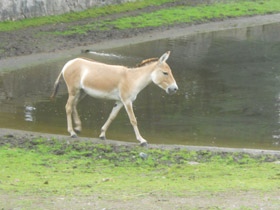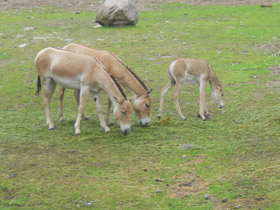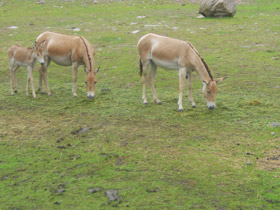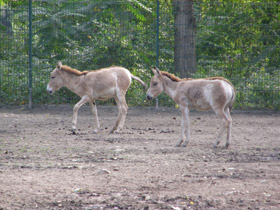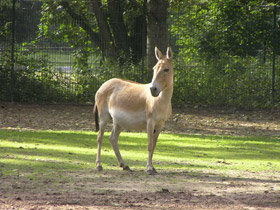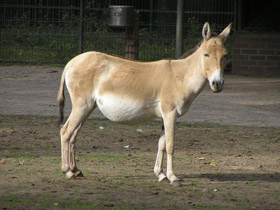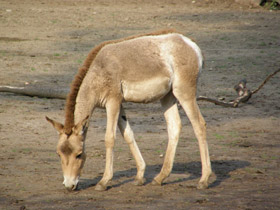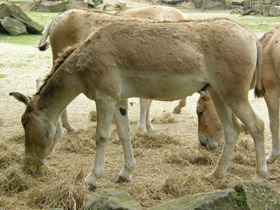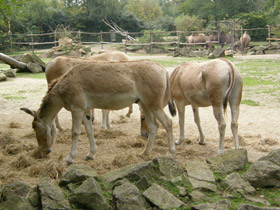The onager or hemione or Asiatic wild ass (Equus hemionus)
 The onager or hemione or Asiatic wild ass (Equus hemionus) is listed in the Russian Red Data Book
The onager or hemione or Asiatic wild ass (Equus hemionus) is listed in the Russian Red Data Book
The onager (/ˈɒnədʒər/; Equus hemionus /ˈɛkwəs hɪˈmaɪənəs/), also known as hemione or Asiatic wild ass, is a species of the family Equidae native to Asia. A member of the subgenus Asinus, the onager was described and given its binomial name by German zoologist Peter Simon Pallas in 1775. Six subspecies have been recognized, two of which are extinct.
Habitat and peculiarities
Equus hemionus is a species of equid from the steppes and mountains of Asia similar to the domestic donkey, but more robust and of larger head and overall body size than the domestic donkey.
"Hemion" and "onager" are Greek words meaning, respectively, "half-ass" and "wild ass".
This is another rare Asian wild donkey species, very similar in appearance to the kiang but somewhat smaller. Equus hemionus inhabits the deserts and semi-deserts of western, central and central Asia. They have incredible cup-shaped hooves. The tips of the two-layered hooves are made of a very hard horny material that forms ridges like the heels of a horseshoe and allows Equus hemionus to run over hard ground or climb rocks like wild goats. When in danger, Equus hemionus can reach speeds of up to 70 km/h and maintain a steady pace for several kilometres. In winter, when desert temperatures drop to -40 degrees Celsius, Equus hemionus develops a thick undercoat and the hairs grow to 5-7 cm in length.
Reproduction and condition
In the rutting season, the male starts galloping in front of the females, holding his head high, running around the herd, jumping, shouting, rolling on his back, tearing and throwing tufts of grass.
The subspecies Equus hemionus khur is listed as endangered on the International Red List.
Diet
Like all equids, onagers are herbivorous mammals. They eat grasses, herbs, leaves, fruits, and saline vegetation when available, but browse on shrubs and trees in drier habitats. They have also been seen feeding on seed pods such as Prosopis and breaking up woody vegetation with their hooves to get at more succulent herbs growing at the base of woody plants.
During the winter, onagers also eat snow as a substitute for water. When natural water sources are unavailable, the onager digs holes in dry riverbeds to reach subsurface water. The water holes dug by the onagers are often subsequently visited by domestic livestock, as well as other wild animals. Water is also found in the plants on which the onagers feed.
During spring and summer in Mongolia, the succulent plants of the Zygophyllaceae form an important component of the diet of the Mongolian wild ass.
Predation
The onager is preyed upon by predators such as Persian leopards and striped hyenas. A few cases of onager deaths due to predation by leopards have been recorded in Iran. Though leopards do not usually feed on equids as in Africa, this may be because Persian leopards are larger and strong enough to prey on Asiatic wild asses.
In the Middle East and the Indian subcontinent, Asiatic lions and tigers were the main predators of onagers. They were also formerly preyed upon by dholes, Asiatic cheetahs, and possibly bears, though they may have mostly preyed only on onager foals. In India, mugger crocodiles can be great threats to onagers during migratory river crossings.
Currently, the main predator for onagers are gray wolves. However, like most equids, they are known to have antipredator behaviour. Groups of stallions cooperate and try to chase off predators. If threatened, onagers defend themselves and violently kick at the incoming predator.
Subspecies
Five widely recognized subspecies of the onager include:
- Mongolian wild ass (khulan) (Equus hemionus Hemionus) - Nominate subspecies. Northern China, eastern Kazakhstan, Mongolia, and Siberia. Synonym: bedfordi (Matschie 1911).
- Turkmenian kulan (kulan) (Equus hemionus Kulan) - One of the largest subspecies of onager. It is 200–250 cm (79–98 in) long, 100–140 cm (39–55 in) tall at the withers, and weighs 200–240 kg (440–530 lb). Male onagers are larger than the females. Northeastern Iran, Northern Afghanistan, western China, Kazakhstan, southern Siberia, Tajikistan, Turkmenistan, Ukraine, Northern Mongolia, and Uzbekistan. Synonym: finschi (Matschie, 1911).
- Persian onager (gur) (Equus hemionus Onager) - Afghanistan, Iran and Pakistan.
- Indian wild ass (khur) (Equus hemionus Khur) - Southern Afghanistan, India, southeast Iran and Pakistan. Synonym: indicus (Sclater, 1862).
- †Syrian wild ass (hemippe) (Equus hemionus Hemippus) - Smallest subspecies, also the smallest form of Equidae. Western Iran, Iraq, Israel, Jordan, Saudi Arabia, Syria, and Turkey. Synonym: syriacus (Milne-Edwards, 1869).
- †European wild ass (hydruntine) (Equus hemionus Hydruntinus) - Formerly thought to be a distinct species, shown to be a subspecies of Onager by genetic studies in 2017. Europe, Western Asia.
A sixth possible subspecies, the Gobi khulan (Equus hemionus luteus, also called the chigetai or dziggetai) has been proposed, but may be synonymous with Equus hemionus hemionus.
Debates over the taxonomic identity of the onager occurred until 1980. As of 2015, four living subspecies and one extinct subspecies of the Asiatic wild ass have been recognized. The Persian onager was formerly known as Equus onager, as it was thought to be a distinct species.

















